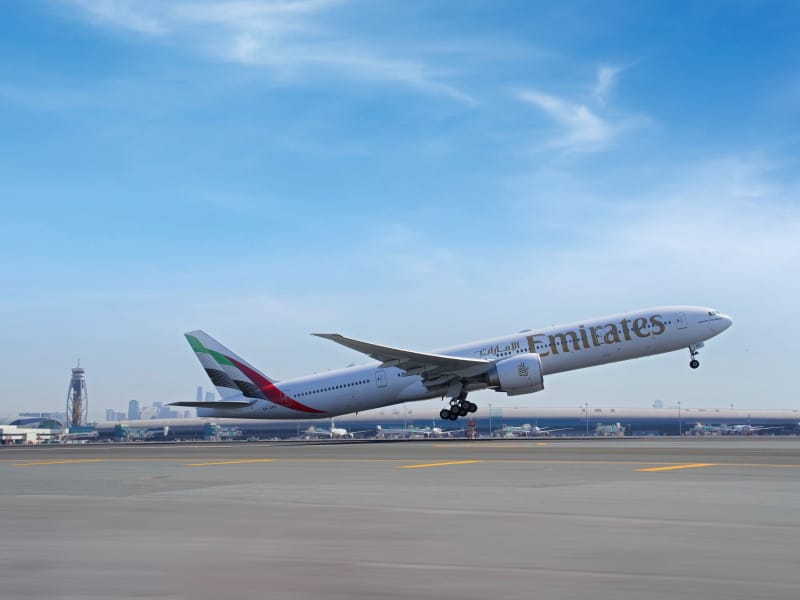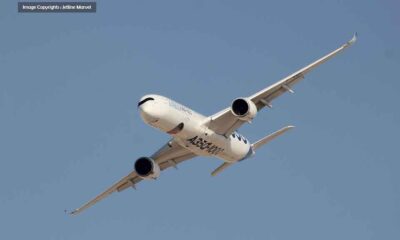Aviation
The Emirates brand value grew 17% over last year to reach US$ 7.7 billion..!!

DUBAI, UAE, 2 February 2016: Emirates has come out on top again as the world’s most valuable airline brand, according to the 2016 Brand Finance Global 500 report, which was released yesterday.
The airline’s brand value grew 17% over last year to reach US$ 7.7 billion. For the fifth year running, the airline has steadily risen up in the global ranking of the world’s top brands to be placed at #171, 47 places above the next closest airline brand. Emirates also retains its well-established position as the most valuable brand in the Middle East. In addition, Emirates’ brand value has more than doubled since 2009, when it first appeared on the Brand Finance Global 500 report.
Emirates’ solid brand positioning is grounded in its commitment to delivering best-in-class products and services both in the air and on the ground, and staying attuned to its customers’ needs.
Boutros Boutros, Divisional Senior Vice President Corporate Communications, Marketing & Brand for Emirates said: “We invest strategically in building our brand and it is reflected in everything we do. We have differentiated the Emirates brand not only through our marketing and sponsorships initiatives, but also through our competitive combination of quality products and services, and technology-driven customer initiatives that our teams deliver everyday both on the ground and on board. We work hard to identify, anticipate, and meet the ever-changing needs of our diverse global audiences, as we firmly believe that this will position us to outperform in our industry now and in the future.”

Emirates A380 and Jetman Dubai formation flight. Photos courtesy of XDubai

Emirates received 26 aircraft in 2015
Brand Finance CEO David Haigh said: “Emirates continues to soar, adding 17% to its brand value this year. Brand Finance’s analysis shows that Emirates is more popular than ever– its brand equity scores for consumer factors such as familiarity, consideration, preference, satisfaction and recommendation are up across the board. Emirates’ growth this year, which builds on impressive historic trends, suggests that by 2020 it could become the first Middle Eastern brand to enter the top 100 of our ranking.”
2015 was another year of growth and innovation for the airline, as Emirates marked 30 years of operations. During the year, Emirates launched six new points, expanding its network to 150 destinations. Emirates also received 26 aircraft, retaining its position as the world’s largest operator of the Boeing 777 and the ever-popular Airbus A380. The airline currently serves 37 cities around the world with the iconic double-decker A380, which features its trademark Onboard Lounge and Shower Spa and industry-leading First Class private suite.
Continuing to invest in technology, the airline also rolled out initiatives to streamline the customer experience including enhancements to its mobile sites and Apps to simplify the customer journey. Emirates also rolled out its newest version of the in-flight entertainment system, ice, on its newly delivered Boeing 777 and Airbus A380 aircraft, featuring the largest in-seat screens in the industry for First and Economy Class. The Emirates ice system has won the best In-Flight Entertainment Skytrax award for 11 for consecutive years.
Source : Emirates officials
Reported : Jetline Marvel
Liked it ..!?
Share with your friends and family.

Aerospace
India is set to build a central command for the Air Traffic Control system, called ISHAN

India’s air traffic growth has led to increased responsibilities for air traffic control. The Airports Authority of India (AAI) is considering centralizing air traffic control for aircraft, dividing the country into four regions. The goal is to consolidate India’s segmented airspace into a single entity to improve air traffic management (ATM) efficiency, safety, and smoothness.
Recently, the AAI invited expressions of interest to develop a detailed project report for the Indian Single Sky Harmonized Air Traffic Management (ISHAN) initiative in Nagpur. Under this plan, air traffic controllers in Nagpur would handle domestic flights flying above 25,000 feet, eliminating the need for coordination among controllers in different regions.
For domestic regional flights operating above 25,000 feet, control would shift to the central command in Nagpur. This consolidation aims to enhance airline operations, increase flight handling capacity, and reduce congestion and flight times for passengers.
Currently, the AAI provides ATM services over Indian airspace and adjoining oceanic areas, covering over 2.8 million square nautical miles. This airspace is divided into four flight information regions (FIRs) in Delhi, Mumbai, Kolkata, and Chennai, along with a sub-FIR in Guwahati.
FIRs are responsible for providing air traffic services, including weather information, visibility, and search and rescue assistance. The proposed unification under the ISHAN initiative aligns with the projected growth of the aviation industry, which anticipates a doubling of domestic passenger traffic by 2030.
Aviation
Airbus is set to increase the production rate for the A350 as demand surges

Airbus SE is set to boost production of its advanced A350 widebody jet as it capitalizes on rising demand for long-distance travel and wide-body aircraft, amidst the ongoing crisis affecting its competitor Boeing due to issues with the B737 Max.
The surge in orders for Airbus’s A350 aircraft has instilled confidence in the company, prompting them to ramp up production rates. This move is particularly advantageous as Boeing continues to grapple with production quality issues surrounding its 787 and 777x aircraft.
In 2024 alone, Airbus has received 137 orders for the A350, signaling a need to expand manufacturing capabilities to meet customer demands. With 1,277 orders received and 592 aircraft delivered as of April 2024, Airbus is poised to fulfill pending deliveries efficiently.
The European aircraft manufacturer announced plans to increase production of A350 jets to 12 per month by 2028, surpassing earlier projections aiming for 10 per month by 2026. This decision was disclosed alongside the company’s first-quarter figures.
The Asian market is proving lucrative for the A350, with significant orders from airlines like Indigo and Air India, totaling nearly 70 aircraft commitments for the future. Meanwhile, Airbus is progressing with its A220 and A320 programs, aiming for a monthly production rate of 14 and 75 aircraft, respectively, by 2026. Additionally, the long-range A321XLR is anticipated to commence service in the third quarter of the current year.
In contrast, Boeing has been compelled to scale back production due to regulatory pressures aimed at enhancing factory processes. While Airbus anticipates a positive market outlook, Boeing continues to face challenges with FAA certification and quality approvals, resulting in ongoing delays for its 737 Max and 777x models.
Financially, Boeing reported a significant cash burn of $3.9 billion in the first quarter, leaving it with $7.5 billion in cash and short-term securities by the quarter’s end, down from $16 billion at the beginning of the year. Consequently, Boeing’s stock has plummeted by 38% in the year so far, contrasting with Airbus’s 14% gain, marking Boeing’s lowest performance in over a year.
For a full listing including details on customers and regions, as well as historical data for the previous year, go to the download section below.
- March 2024 deliveries: 63 deliveries to 32 customers
- March 2024 gross orders: 137
- 2024 deliveries to date: 142 deliveries to 45 customers
| Single-Aisle | A300/A310 | A330 | A340 | A350 | A380 | TOTAL | |
|---|---|---|---|---|---|---|---|
| Total Orders | 19470 | 816 | 1774 | 377 | 1277 | 251 | 23965 |
| Total Deliveries | 11705 | 816 | 1598 | 377 | 592 | 251 | 15339 |
| Aircraft in Operation | 11007 | 271 | 1482 | 202 | 591 | 234 | 13787 |
Aviation
All passengers killed in plane crash, after pilot let his children to control the plane

When boarding a plane, passengers entrust their safety to the skilled hands of the pilot. However, tragedy struck when one of the flight ended in disaster as all passengers lost their lives in a horrific plane crash.
In 1994, during a flight from Moscow to Hong Kong, tragedy struck as an Aeroflot relief pilot made a fateful decision. In a move that would have devastating consequences, the pilot invited his own children into the cockpit to play with the controls. Little did anyone know, this seemingly innocent gesture would lead to the loss of all 75 lives aboard the aircraft.
It was a seemingly innocent act that led to catastrophic results. The relief pilot, Mr. Kudrinsky, invited his two children, Yana, 12, and Eldar, 15, into the cockpit during the late hours of the night. Little did anyone know, this simple gesture would set off a chain of events that would end in tragedy.
Once in the cockpit, the children were allowed to sit in the captain’s chair and play with the controls, unaware that they should have been disabled as the plane was in autopilot mode.
Eldar, perhaps in a moment of curiosity or innocence, held the control column down for a mere 30 seconds. Yet, in those brief moments, the autopilot disengaged, thrusting the aircraft into manual control.
By the time the pilots regained their seats and attempted to regain control, it was too late. Despite their efforts to pull the plane out of a dive, they overcorrected, causing the flight to climb almost vertically, ultimately stalling it.
Final moment Flight 593 crash
In the final moments, as the pilots struggled to stabilize the aircraft, Flight 593 crashed into the Kuznetsk Alatau Mountain range in southern Russia, completely obliterating the plane and claiming the lives of everyone on board.
Investigations revealed a chilling truth: there was no evidence of technical failure. Instead, the crash was attributed to the unthinkable decision to allow inexperienced hands to manipulate the controls of a commercial aircraft.
The black box recording captured the harrowing sequence of events, providing a grim reminder of the human cost of a lapse in judgment. In just over two minutes, the lives of all on board were tragically short, leaving behind a legacy of sorrow and unanswered questions.




























